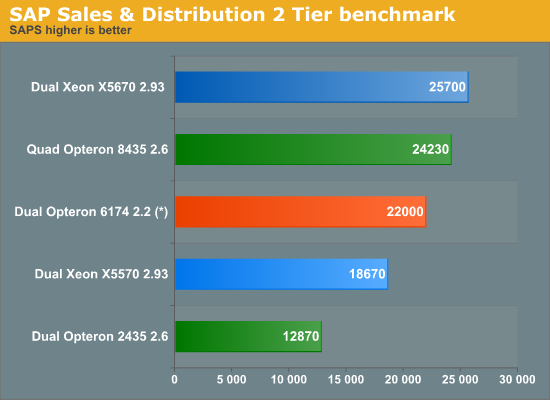AMD's 12-core "Magny-Cours" Opteron 6174 vs. Intel's 6-core Xeon
by Johan De Gelas on March 29, 2010 12:00 AM EST- Posted in
- IT Computing
SAP S&D 2-Tier
| SAP S&D 2-Tier | |
| Operating System | Windows 2008 Enterprise Edition |
| Software | SAP ERP 6.0 Enhancement package 4 |
| Benchmark software | Industry Standard benchmark version 2009 |
| Typical error margin | Very low |
The SAP SD (sales and distribution, 2-tier internet configuration) benchmark is an interesting benchmark as it is a real world client-server application. We decided to take a look at SAP's benchmark database. The results below all run on Windows 2003 Enterprise Edition and MS SQL Server 2005 database (both 64-bit). Every 2-tier Sales & Distribution benchmark was performed with SAP's latest ERP 6 enhancement package 4. These results are NOT comparable with any benchmark performed before 2009. The new 2009 version of the benchmark produces scores that are 25% lower. We analyzed the SAP Benchmark in-depth in one of our earlier articles. The profile of the benchmark has remained the same:
- Very parallel resulting in excellent scaling
- Low to medium IPC, mostly due to "branchy" code
- Somewhat limited by memory bandwidth
- Likes large caches (memory latency!)
- Very sensitive to sync ("cache coherency") latency

(*) Estimate
The last time we discussed the SAP S&D 2-tier benchmark, we had to estimate the Xeon X5670 results. Since then HP has benchmarked its latest G6 servers, giving us results for the X5670. The performance is nothing short of astonishing. The dual Xeon X5670 outperforms a quad Opteron 8345 at 2.6 GHz. The Magny-Cours Opteron can only compete based on its somewhat lower price. We doubt that the SAP buyers care about a few hundred dollars though. A quad Opteron 6174 might have a chance against the Nehalem EX performance wise, but the SAP market will probably prefer the extensive RAS list of the Xeon Nehalem EX. The ERP market is most likely going to be dominated by Intel based servers.










58 Comments
View All Comments
Accord99 - Monday, March 29, 2010 - link
The X5670 is 6-core.JackPack - Tuesday, March 30, 2010 - link
LOL. Based on price?Sorry, but you do realize that the majority of these 6-core SKUs will be sold to customers where the CPU represents a small fraction of the system cost?
We're talking $40,000 to $60,000 for a chassis and four fully loaded blades. A couple hundred dollars difference for the processor means nothing. What's important is the performance and the RAS features.
JohanAnandtech - Tuesday, March 30, 2010 - link
Good post. Indeed, many enthusiast don't fully understand how it works in the IT world. Some parts of the market are very price sensitive and will look at a few hundreds of dollars more (like HPC, rendering, webhosting), as the price per server is low. A large part of the market won't care at all. If you are paying $30K for a software license, you are not going to notice a few hundred dollars on the CPUs.Sahrin - Tuesday, March 30, 2010 - link
If that's true, then why did you benchmark the slower parts at all? If it only matters in HPC, then why test it in database? Why would the IDM's spend time and money binning CPU's?Responding with "Product differentiation and IDM/OEM price spreads" simply means that it *does* matter from a price perspetive.
rbbot - Saturday, July 10, 2010 - link
Because those of us with applications running on older machines need comparisons against older systems in order to determine whether it is worth migrating existing applications to a new platform. Personally, I'd like to see more comparisons to even older kit in the 2-3 year range that more people will be upgrading from.Calin - Monday, March 29, 2010 - link
Some programs were licensed by physical processor chips, others were licensed by logical cores. Is this still correct, and if so, could you explain in based on the software used for benchmarking?AmdInside - Monday, March 29, 2010 - link
Can we get any Photoshop benchmarks?JohanAnandtech - Monday, March 29, 2010 - link
I have to check, but I doubt that besides a very exotic operation anything is going to scale beyond 4-8 cores. These CPUs are not made for Photoshop IMHO.AssBall - Tuesday, March 30, 2010 - link
Not sure why you would be running photoshop on a high end server.Nockeln - Tuesday, March 30, 2010 - link
I would recommend trying to apply some advanced filters on a 200+ GB file.Especially with the new higher megapixel cameras I could easilly see how some proffesionals would fork up the cash if this reduces the time they have to spend in front of the screen waiting on things to process.